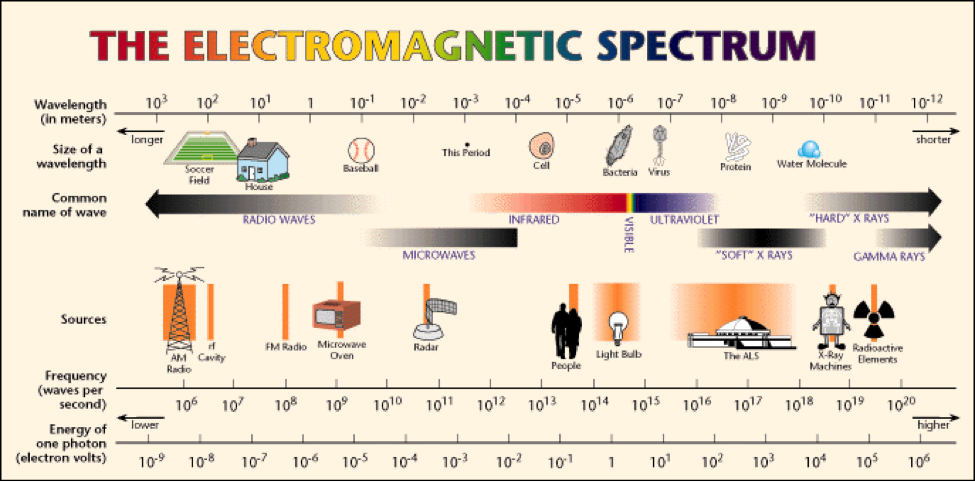To Microwave or Not to Microwave?
Percy Spencer worked for Raytheon as a specialist in Magnetron tubes that were used for radar during World War II. One day as he was working with an active tube, he noticed the candy bar in his pocket had melted. He decided to look into the phenomenon and tested many things near the tube including popcorn (the first microwave popcorn) and an egg (which blew up). He put one of the tubes into a metal box and did more experiments. His experiment of cooking food turned into the microwave oven we know today. Raytheon patented the idea in 1945, and Spencer got paid $2.00 for it.
The electromagnetic waves that travel throughout the Universe include the light we see, as well as many forms of radiation. Some are high-energy that can damage proteins and DNA in the body, and others have little or no effect. Microwaves are on this electromagnetic spectrum as seen in the image.[1]
As you can see, the shorter the wavelength, the higher the energy and the more damage it causes. GAMMA RAYS are at the other end of the spectrum from microwaves and considered radioactive. Anything to the left of the VISIBLE spectrum on the chart is non-ionizing. This means it releases low energy in the form of heat but doesn’t have enough energy to product an effect on the atomic level.
Microwaves are lower energy than a radar, but higher than an FM radio. The longer the wavelength, the more they can penetrate a substance before releasing energy. Microwaves are effectively the shortest radio waves. This is why it is said that microwaves “cook food from the inside out.” The distance between the invisible up and down pattern of electricity in a microwave is about the diameter of a basketball.
This is why they can put a metal screen with holes in the door of a microwave so you can see inside and let the light waves out, which are as small as a bacteria, but not any of the electromagnetic waves. The energy is contained within the oven like a mirrored box with a light in it — the light just bounces around the mirrors.
Incidentally, the “millimeter wave” detectors at airport security use electromagnetic radiation in the same microwave spectrum.
The advantage of using nearly the same wavelength as radar allows it to pass transparently through lightweight materials, such as clothing, to detect metals and dense materials without causing ionization, which could be damaging like X-rays.
If you think about it, the fact that we can heat food without heating its container is no less than miraculous! Microwaves cause polar molecules (like water, sugar, and oil) that have one positive end and a negative end to vibrate as they absorb the energy from the wave. Vibration is given off as heat. This is not unlike an infrared heat lamp or the red glow of a burner on the stove. The faster molecules move, the more they are perceived as hot. Molecules that are not polar, such as glass and plastic, don’t absorb the microwaves, and thus do not heat up.
Some ceramics contain metal, which can cause it to heat up in the microwave oven. Metal has charges that can move around, which is why it can conduct electricity and cause a spark. Small bits of metal in a container can cause the container to heat up. Generally, the microwaves reflect off metal. All the hype about not putting metal objects in a microwave oven is mainly to avoid sparks, which can burn plastic or set fires. Also, if you cover food with aluminum foil, the microwaves will bounce off and not heat the food.
What happens if you turn on a microwave oven with nothing in it?
The old microwave ovens had the tube source directly in the oven, which heated the tube and destroyed it. The new microwave energy travels through a waveguide/window and is distributed into a metal cavity where the food is cooked. This protects the tube from damage. However, the energy in the oven will increase because there is nothing inside to absorb it, and it can heat up anything that absorbs even a small amount.[2]Turning microwaves on without any food inside, even for a few minutes or more, does not damage modern ovens.
What should I do if I see sparks?
Turn it off. It won’t hurt anything, and it doesn’t ruin the microwave oven. If any plastic is burned, best to throw it away, and don’t eat the food, for reasons we’ll discuss later.
What about the plants that died after being watered with microwaved water?
There was an email with pictures of plants that circulated in 2010 claiming to be a science fair project done by a student. The project compared plants watered with either stovetop or microwave-heated and cooled water. The pictures included thriving and dying plants. The thriving plants were apparently watered with cooled stovetop water. The dying plants were anemic and allegedly watered with cooled microwave water. However, many have attempted to repeat this experiment, but without the same outcome. All plants do equally well, no matter which kind of water is used.[3]
Do microwaves destroy vitamins?
Heat destroys some vitamins, so the higher the heat, the more vitamins are destroyed. Vitamin C, for example is changed by heat.
The second issue is cooking with water. When food is cooked in water, the water-soluble vitamins are leached out, so the food has less – as much as 80% less – of these vitamins. Using little or no water in a microwave oven is a good way to retain the nutrient content of your food.[4]
Even institutional microwaves that are twice the power of home models provide favorable results compared to conventional methods. The most important factor in retaining water-soluble vitamins is to use less water. Previous studies of the effect of microwave ovens on the nutrients in food showed a loss of vitamins simply because vegetables were cooked in water.[5]The answer, then, is that the microwaves do not destroy vitamins.
Does the microwave oven cause more heat than conventional cooking?
Higher heat is a problem for food for two reasons:
- More nutrients are destroyed.
- Substances such as nitrosamines that are toxic might be created.
The principle of heating food in a microwave oven is based on kinetic energy. As water molecules rotate, they bump into other molecules surrounding them and transfer energy as heat. The high-energy water releases steam to prevent food from overheating. Oils and fats may get hotter because they have a higher temperature of vaporization — if there is no water in the food. Research mostly shows microwaves preserve vitamins better than in boiled water. Steaming is as good as a microwave. Frying and grilling generally require higher temperatures than a microwave destroy more vitamins. [6]
One study looked at the level of nitrosamines in bacon cooked in a frying pan vs. in a microwave oven. The frying method produced significantly more toxic nitrosamines than the microwave oven.[7] Conventional ovens and toaster ovens can heat food hotter than a microwave oven and also destroys more nutrients. If you look at the ELECTROMAGNETIC SPECTRUM above, the conventional oven falls in the INFRARED area and is higher energy than the microwaves, about a thousand times more energy per photon.
Is plastic in a microwave oven dangerous?
When some plastics burn, they make a chemical called dioxin which is quite toxic and associated with certain cancers. Unless there is something metal in the microwave oven that is creating sparks, the food doesn’t get hot enough to release dioxins. However, if bacon or other grease melts or causes browning of the plastic container it’s best not to eat it. In fact, it’s best not to cook bacon in a plastic container.
There are some other substances such as phthalates and bisphenol-A (BPA) that leach out of plastic. These are endocrine disrupters, which means they have a negative effect on the hormone system. Containers that say they are microwave safe means they can cook food without leaching significant amounts of these chemicals. Other plastics might be microwave safe, but if they aren’t tested, then they won’t say they are safe.[8]It’s best not to use plastics in the microwave oven that don’t specifically state they are microwave safe. Even plastic bags or plastic food wrap should not touch the food that is being heated.
How do I keep the nutrients in my food when cooking it?
Raw food has the most nutrient value. If you cook your food less, the nutrient value will be higher. Also, avoid cooking vegetables in water, use steam or a microwave oven instead. If you fry or grill with high heat, do it for only a short time. When you re-heat something in the microwave oven, don’t overheat it – just enough to get it to the right temperature.
We are surrounded by microwaves every day, all day. We use radios, cell phones, and all sorts of wireless communication that is electromagnetic radiation. Microwaves are energy waves just like infrared, and light. When used properly, they can make our lives easier, such as the amazing microwave oven!
Sources:
[1]https://www2.lbl.gov/MicroWorlds/ALSTool/EMSpec/EMSpec2.html
[2]https://www.quora.com/What-happens-if-you-start-a-microwave-with-nothing-inside-it
[3]https://www.mcgill.ca/oss/article/you-asked/will-watering-plants-heated-microwaved-water-kill-them
[4]https://www.nytimes.com/2006/10/17/health/17real.html
[5]https://www.ncbi.nlm.nih.gov/pubmed/3894486
[6]https://www.quora.com/What-happens-if-you-start-a-microwave-with-nothing-inside-it
[7]https://www.ncbi.nlm.nih.gov/pubmed/2744660
[8]https://www.health.harvard.edu/staying-healthy/microwaving-food-in-plastic-dangerous-or-not

























